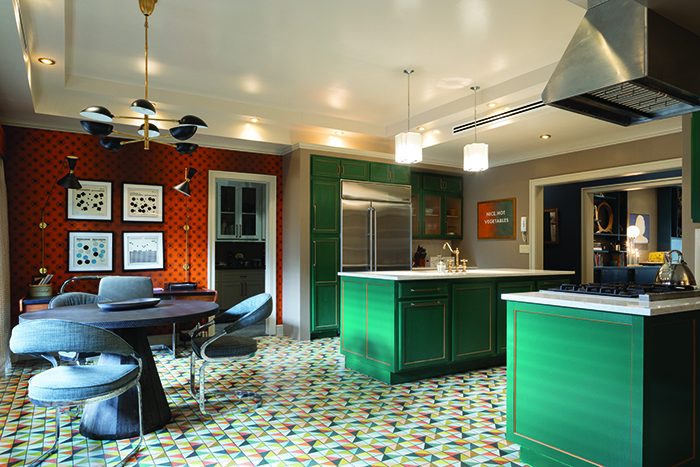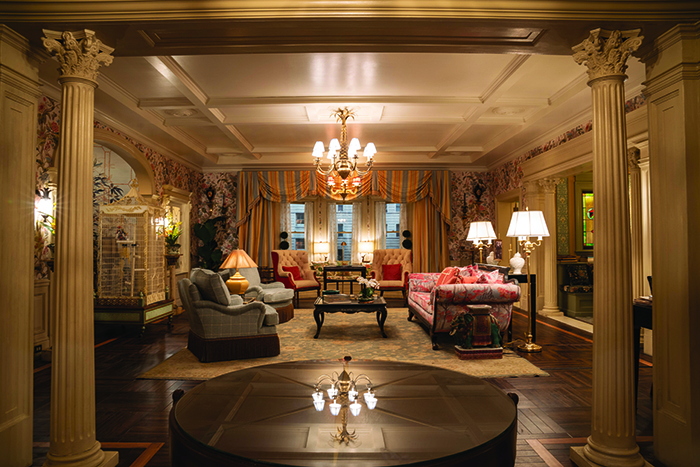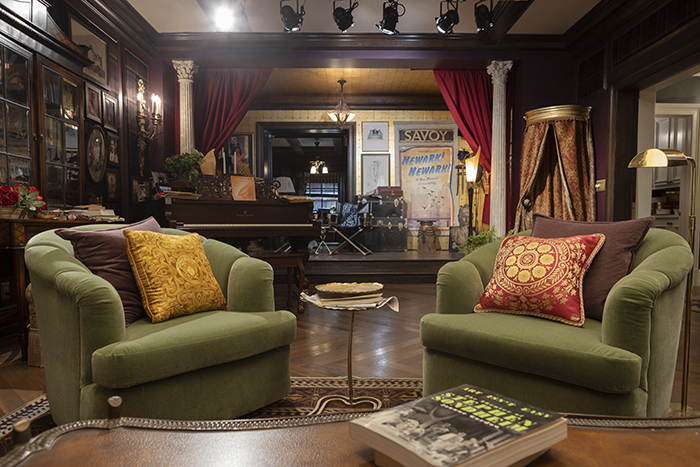
From left: Production designer Curt Beech, art director Jordan Jacobs, and Rich Murray, AB’94, with their Emmys for Only Murders in the Building. (Amy Sussman/Getty Images Entertainment via Getty Images)
Rich Murray, AB’94, finds the stuff of life for beloved TV characters.
Growing up in Kankakee, Illinois, Rich Murray was a Star Wars fan—and not just a casual one. He knew the movies beginning to end. He bought the books. And he especially loved the action figures, which he collected diligently and still owns today.
But there was a problem. “Loved the figures,” says Murray, “disliked the play sets”—the plastic backdrops that accompanied the toys. To his exacting eye, they were never quite right and often didn’t function as advertised. So Murray, AB’94, took matters into his own hands, rebuilding the play sets out of cardboard so he could create the perfect scenery for Luke, Leia, and Han’s adventures.
It was, in retrospect, Murray’s very first gig in set design (unpaid, nonunion). In the years since, he’s swapped scissors and cardboard for paint and furniture, but he’s still chasing the same goal: scenery that makes a story feel real.
Since the early 2000s, Murray has worked in theater, film, and television both as a set designer, creating the overall look and feel of a production, and a set decorator, selecting and sourcing the furniture and other elements of decor.
If you delighted in Oliver’s Broadway show posters or Mabel’s boho chic couch in the Hulu mystery series Only Murders in the Building, you’re an admirer of Murray’s work. If you didn’t, well, that’s OK. “Lighting designers often say, you only notice our work when it’s wrong,” says Murray. It’s the same for set decorators: “You may not ever even notice it when it’s right.”
Emmy voters did take notice of the work, and of sets done right. In September Murray, along with Only Murders production designer Curt Beech and art director Jordan Jacobs, received the award for Outstanding Production Design for a Narrative Program (Half-Hour)—his first nomination and win.
Only Murders, Murray says, was a dream job from the start and the award simply an added bonus: “There’s a magic about being on the right team in the right place at the right time.” His Emmy statue now sits on a bookshelf alongside his LEGOs and books. “It’s a place of honor,” he says, “if you consider all the LEGOs honorable.”
Murray’s first formal exposure to set design came as a UChicago undergraduate in a course taught by Linda Buchanan, a veteran of the Chicago theater scene. He was instantly hooked. “It was a different way of reading scripts. It wasn’t as an actor, it wasn’t as a director,” he says—a virtue “because I’m really horrible, I think, at acting and directing, and I took all those classes as well.” Sets, by contrast, felt like “a real way of bringing something to life onstage, almost like the set design is another character.”
At the time, he had been considering careers in architecture and design or in law; set design turned out to be “a weirdly perfect marriage of both worlds,” he says. “You’re telling stories and trying to convince an audience that something is real and true.”
Murray got a chance to put his newfound interest into practice with University Theater. Mark Lohman, UT’s technical director at the time, “was instrumental in teaching me the magic of what we do,” Murray says. The atmosphere was informal. There was no theater school and, at the time, not even a theater major; Lohman “just let us play, and that was glorious.” Murray got to design, build, and paint his own sets for UT productions—with help when he needed it but little direct oversight. “There was never a voice,” he recalls, “that said ‘no.’”
After graduating with a General Studies in the Humanities degree, Murray spent seven years working for an accounting firm to make a dent in his student loans. For a day job that wasn’t his passion, it turned out to be unexpectedly useful. The corporate world taught “a lot about how to manage spreadsheets and budgets and deadlines and teams of people in a way that has only helped me on this side now,” he says.
When he told his colleagues he was resigning to go to grad school, they assumed he was off to business school. Not quite, he explained. In the fall of 2001, he enrolled at New York University’s Tisch School of the Arts.
The first day of classes was September 11; Murray and the 20 other students in his set design program watched together as the two towers fell. “That informed our artistic choices for the next three years,” he reflects. He remembers classmates designing sets for the Greek tragedies and Death of a Salesman that were “just piles of rubble,” he says. “That’s how we processed it.”
Murray emerged from Tisch with a portfolio and, not long after, his first job offer, as a set designer on the Fox TV series Point Pleasant. More jobs followed—“once you get a couple of people who can vouch for you, it’s all word of mouth,” he says—such as the film Little Miss Sunshine and TV shows including The Nate Berkus Show, Madam Secretary, and All My Children.
When Murray signed on for Only Murders, he didn’t yet know it would become both beloved and critically acclaimed. It was obvious, however, that the show was a plum job for a set decorator.
Only Murders in the Building is set in a fictional Renaissance Revival–style New York City apartment building called the Arconia. (The real-life Belnord on the Upper West Side stands in for the Arconia in exterior shots.) As the show’s title implies, the setting is central to the story. Murray was tasked with enlivening the apartments of the three protagonists: the extravagant theater director Oliver Putnam (Martin Short), the neurotic actor Charles Haden-Savage (Steve Martin), and the mysterious Mabel Mora (Selena Gomez). In the second season, new characters and spaces were filled out; Murray particularly enjoyed decorating the apartment of longtime Arconia resident and busybody Bunny Folger (Jayne Houdyshell). (One assumes the third season, currently in production, might reveal still more of the Arconia, but Murray can’t divulge any details.)
The first season of Only Murders was filmed from December 2020 to April 2021. For Murray and much of the cast and crew, it was their first project since the COVID-19 pandemic began. Protocols were strict, with masks and face shields required on set, and schedules in flux to accommodate time off for exposure or illness. “It was really, really a tough time,” Murray says, but simultaneously “the most joyous experience I’ve had shooting a show.”
The careful work that went into the production was rewarded by the show’s fans. Murray was especially excited to discover that the sets were being pored over by watchful viewers. “‘Is this a clue?’ is all we hear on the websites and fan groups,” Murray says. Knowing that people are paying such close attention adds a new layer of fun to a job already thick with it. “I could retire now knowing my career has been fulfilled,” he says.
Between seasons one and two of Only Murders, Murray was offered a job on And Just Like That …, the Sex and the City spin-off. It was an easy decision. He’d long been a fan, faithfully watching Sex and the City every Sunday night with his now husband, and relished the thought of working on it. “I’d be stupid,” he says, “to turn down the job where I get to do Carrie Bradshaw’s apartment.”
Reboots and sequels come with their own production challenges—in this case, painstaking reconstruction of sets from the original Sex and the City series and the two films that followed it. Some of the furniture had been saved and put in storage, but other elements had to be rebuilt from scratch. To re-create Carrie and Big’s apartment, Murray tracked down a binder with receipts from the first movie, found the company that made the custom tile for the kitchen, and ordered a fresh batch. No detail was too small.
After a season of American Horror Story, Murray is now back on Only Murders in the Building. He’s decorated apartments in the Arconia. He’s decorated Carrie Bradshaw’s closet. He has an Emmy. Is there anything left to conquer?
Of course there is: “Star Wars. Star Wars. Star Wars,” Murray says. It could happen, with all the new shows and films in production. He’s got hope. “I put it out there,” he says, “in the universe.”
Welcome to the Arconia.
Get comfortable in Murray’s Emmy-winning sets for Only Murders in the Building

The design and decor of Charles Haden-Savage’s elegant bachelor pad was shaped, in part, by Steve Martin’s real-life tastes. Nice Hot Vegetables is a pastel by Ed Ruscha, whose work Martin has collected since the 1960s. (The actor’s involvement, Murray says, eased the process of getting Ruscha’s permission to reproduce the piece—often a challenge when using real works of art.) To re-create it, the production team printed a copy on watercolor paper, then sent it to painters in the scenic department, who colored over it with pastels to give the print authentic tones and textures. “What they do is wizardry,” Murray says.

As a lifelong Arconia resident, Bunny Folger would have wallpaper in her apartment, Murray and his colleagues decided. They found a pattern by William Morris, the famed 19th-century Arts and Crafts designer, that happened to feature rabbits. Then they found a rabbit-adorned tile pattern. Before long, the room had become a veritable hutch, filled with every conceivable form of rabbit decor. The tchotchkes became the setup for a subtle visual gag in the first episode of the second season, in which the camera cuts from a porcelain rabbit figurine to a cast-iron rabbit holding a magnifying glass to a photo of the character. “The camera is saying, here’s bunny, bunny, Bunny,” says Murray. “We have a lot of fun doing things like that.”

For theater director Oliver Putnam’s apartment, “I literally emptied out my storage unit of theater books,” Murray says. “I have a whole collection of Stephen Sondheim LPs that all ended up in Oliver’s set.” The set also features posters from some of Putnam’s doomed Broadway productions; Murray came up with 30 titles, about 10 of which were brought to life as posters in the apartment. Newark! Newark!—production designer Curt Beech’s favorite—enjoys a place of prominence in the living room. It started as a joke but may not remain so: “I’ve written the lyrics to one song,” Murray says. “We’ll see what happens.”
